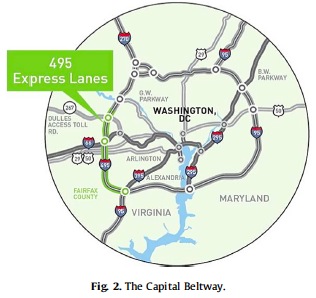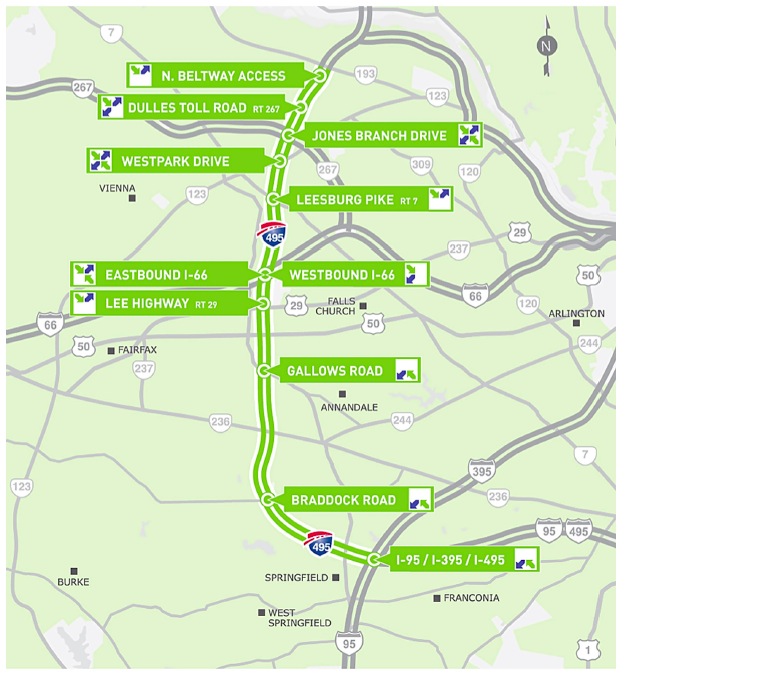GEORGE MASON UNIVERSITY
By Nobuhiko Daito, Zhenhua Chen, Jonathan L. Gifford, Tameka Porter, and John E. Gudgel
Implementing public private partnerships during challenging economic times: Case study of the 495 Express Lanes on the Virginia portion of the Washington Capital Beltway Project
1. Introduction
 How has the 2008 Economic Crisis impacted the design, financing, and construction of highway public–private partnership (PPP or P3) projects in the United States? In December 2007, on the eve of the economic crisis, the Virginia legislature approved a P3 to construct a 14-mile (22.5 km) high occupancy toll (HOT) road (the 495 Express Lanes) to alleviate heavy traffic on the Capital Beltway around Washington, DC. This case study looks at the impact the 2008 Economic Crisis and associated economic challenges between 2008 and 2012 had on this project and considers what governments and other stakeholders should be aware of when implementing P3s during adverse economic times. The hypotheses of the analysis are that, despite the economic downturn, the employment of a P3 procurement approach on the 495 Express Lanes project made it possible to: (1) secure infrastructure investment, which would have been very difficult without the partnership with the private sector; (2) implement a project that was otherwise unfunded within the constrained regional and state long-range transportation plans; (3) deliver the project on-time and on-budget; and (4) achieve higher service quality and potentially life-time operational cost savings (Valila and Timo, 2005).
How has the 2008 Economic Crisis impacted the design, financing, and construction of highway public–private partnership (PPP or P3) projects in the United States? In December 2007, on the eve of the economic crisis, the Virginia legislature approved a P3 to construct a 14-mile (22.5 km) high occupancy toll (HOT) road (the 495 Express Lanes) to alleviate heavy traffic on the Capital Beltway around Washington, DC. This case study looks at the impact the 2008 Economic Crisis and associated economic challenges between 2008 and 2012 had on this project and considers what governments and other stakeholders should be aware of when implementing P3s during adverse economic times. The hypotheses of the analysis are that, despite the economic downturn, the employment of a P3 procurement approach on the 495 Express Lanes project made it possible to: (1) secure infrastructure investment, which would have been very difficult without the partnership with the private sector; (2) implement a project that was otherwise unfunded within the constrained regional and state long-range transportation plans; (3) deliver the project on-time and on-budget; and (4) achieve higher service quality and potentially life-time operational cost savings (Valila and Timo, 2005).
While some states and municipalities have been pondering public–private partnerships in order to fund the operations and maintenance of increasingly deteriorated roads, others are considering aligning with private companies so that they may finance, develop, design, and build roads in addition to performing operations and maintenance functions. These state and local governments are turning to P3 innovations because they believe that these entities can improve capital investments and transportation capacity while upholding existing roadway standards (US Department of Transportation Federal Highway Administration, 2011). With existing P3 legislation, a P3-focused transportation office in place and many years of P3 experience, Virginia is poised to be at the forefront of the P3 project delivery initiative in the coming years.
One of Virginia’s most recent P3 projects has been the design and construction of the 495 Express Lanes (Fig. 1), which began operation on November 17, 2012. The Capital Beltway (Fig. 2) is a 64-mile (103 km) circumferential interstate highway that surrounds the District of Columbia and the nearby Maryland and Virginia suburbs. The original concept of the Beltway dates back to the 1940s when Fred W. Tummler, former director of the National Capital Park and Planning Commission, suggested a freeway that surrounded the Washington suburbs (McDevitt and Betty, 1944). The road was originally envisioned as a bypass thoroughfare for long-distance east coast drivers wishing to avoid traveling directly through Washington. As businesses and industry grew in the Washington suburbs, the Beltway became a popular, heavily traveled highway. Though the road has seen many revitalization projects, excessive traffic is a persistent problem.
About George Mason University
www.gmu.edu
“At Mason, our research mission is to create a safer, more sustained world with extended life quality. We have strategically assembled the following areas that encompass communities of practice whose knowledge and research are oriented towards this goal. Our Research Focus profiles these communities in an effort to foster interdisciplinary research explorations and to facilitate access to both individuals and centers of expertise.”
Tags: Capital Beltway, D.C., George Mason University, GMU, John E. Gudgel, Jonathan L. Gifford, Nobuhiko Daito, Public-Private Partnerships, Tameka Porter, Tolls, VA, Virginia, Washington, Zhenhua Chen







 RSS Feed
RSS Feed